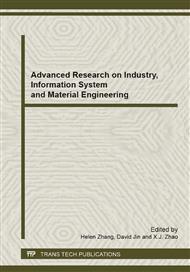p.169
p.175
p.180
p.184
p.188
p.192
p.196
p.200
p.205
Research on Environmental Materials with Variation of Pollutant and Environmental Factor in Underground Environment
Abstract:
The removal efficiency of pollutant in an enhanced remediation with a permeable reactive barrier (PRB) was studied in this paper. The experimental results showed that the DO value has varied obviously because of the oxidation and reduction near the electrodes, i.e. the pH value near the anode changed from 6.3 to 7.9 but near the cathode it varied from 6.5 to 6.4 in the experiment process, which inflected that the variation content of the DO near anode chamber was bigger than that of the anode chamber during the electrokinetic remediation process. The removal efficiency of Cd was respectively 63.91% near the anode and 86.79% near the cathode, and the removal efficiency of COD was respectively 44.86% near the anode and 90.31% near the cathode at the end of experiment when the experimental voltage gradient was 0.35V/cm, which indicated that this new enhanced electrokinetic remediation of groundwater was more effective method than that of ordinary PRB containing environmental materials.
Info:
Periodical:
Pages:
188-191
Citation:
Online since:
March 2013
Authors:
Keywords:
Price:
Сopyright:
© 2013 Trans Tech Publications Ltd. All Rights Reserved
Share:
Citation:


